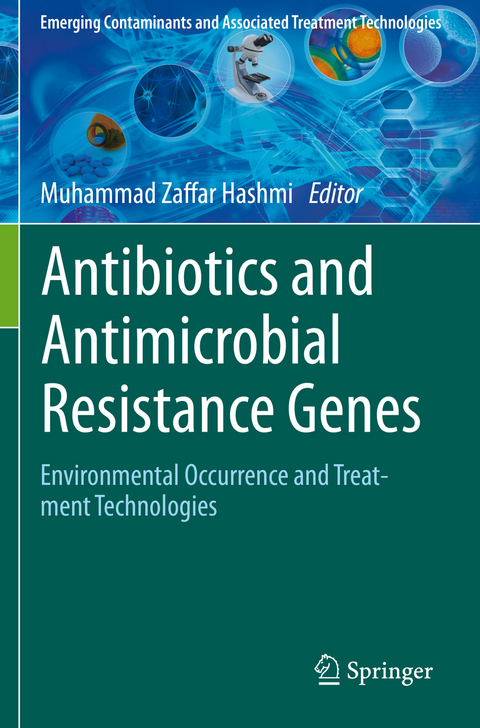
Antibiotics and Antimicrobial Resistance Genes
Springer International Publishing (Verlag)
978-3-030-40424-6 (ISBN)
This volume summarizes and updates information about antibiotics and antimicrobial resistance (AMR)/antibiotic resistant genes (ARG) production, including their entry routes in soil, air, water and sediment, their use in hospital and associated waste, global and temporal trends in use and spread of antibiotics, AMR and ARG. Antimicrobial/antibiotic resistance genes due to manure and agricultural waste applications, bioavailability, biomonitoring, and their Epidemiological, ecological and public health effects. The book addresses the antibiotic and AMR/ARG risk assessment and treatment technologies, for managing antibiotics and AMR/ARG impacted environments
The book's expert contributions span 20 chapters, and offer a comprehensive framework for better understanding and analyzing the environmental and social impacts of antibiotics and AMR/ARGs. Readers will have access to recent and updated models regarding the interpretation of antibiotics and AMR/ARGs in environment and biomonitoring studies, and will learn about the management options require to appropriately mitigate environmental contaminants and pollution. The book will be of interest to students, teachers, researchers, policy makers and environmental organizations.
Dr. Muhammad Zaffar Hashmi is Assistant Professor of Environmental Engineering in Department of Meteorology, COMSATS University Islamabad Campus, Pakistan. Dr. Hashmi works on multiple water, soil, air and health related issues. Dr. Hashmi has expertise in developing environmentally sustainable and feasible technologies including bioremediation, using innovative microbes and genes, plants, and microcosms. He has edited three books through the eminent publisher Springer such as Xenobiotics in The Soil Environment, Antibiotics and Antibiotics Resistance Genes in Soils and Environmental Pollution of Paddy Soils which have been used at universities, research institutions and innumerable colleges all over the world. Dr. Hashmi has worked as a consultant for Indus River Disaster Management WWF Pakistan. Dr. Hashmi has served as reviewer for 2nd International Conference on Agriculture and Biological Sciences (ABS2016), China.
Chapter 1-Global and temporal trends in the use of antibiotics and spread of antimicrobial resistance. Chapter 2-Trends in antimicrobial use in food animals, aquaculture, and hospitals waste. Chapter 3-Antibiotics use in hospitals and their presence in the associated waste. Chapter 4-Environmental dissemination of antimicrobial/antibiotic resistance genes and correlation to anthropogenic contamination with antibiotics. Chapter 5-Antimicrobial/antibiotic resistance gene due to manure and agricultural waste applications. Chapter 6-Natural resistome and environmental microorganisms producing antibiotics. Chapter 7-Antimicrobial and antibiotic resistance genes in the environment. Chapter 8-Entry routes of antibiotics and antimicrobial resistance in the environment. Chapter 9-Databases, multiplexed PCR, and next generation sequencing (NGS) technologies for tracking AMR genes in the environment. Chapter 10-Fate of antibiotics and AMR/ARGs in Environment. Chapter 11-Bio-monitoring of antibiotics and AMR/ARGs. Chapter 12-Long range transport of antibiotics and AMR/ARGs. Chapter 13-Uptake mechanism of antibiotics into biota. Chapter 14-Antibiotics and AMR/ARGs transfer into food chains. Chapter 15-Bioavailability of antibiotics and their toxicity. Chapter 16-Metagenomics and methods development for determination of antibiotics and AMR/ARGS. Chapter 17-Antibiotics and resistance genes in wastewater treatment plants. Chapter 18-Global trends in ARGs as measured by a high throughput qPCR platform. Chapter 19-Surveillance and environmental risk assessment of antibiotics and AMR/ARGs. Chapter 20-Epidemiological, ecological and public health effects of antibiotics and AMR/ARGs. Chapter 21-Bio-management of antibiotics. Chapter 22-Treatment technologies and management options of antibiotics and AMR/ARGs. Chapter 23-Quantitative microbial risk assessment and AMR. Chapter 24-Overview of treatment technologies for AMR genes. Chapter 25-Modelling of antibiotics and AMR/ARGs. Chapter 26-Future perspectives about antibiotics and AMR management.
| Erscheinungsdatum | 09.04.2021 |
|---|---|
| Reihe/Serie | Emerging Contaminants and Associated Treatment Technologies |
| Zusatzinfo | XXII, 456 p. 64 illus., 39 illus. in color. |
| Verlagsort | Cham |
| Sprache | englisch |
| Maße | 155 x 235 mm |
| Gewicht | 729 g |
| Themenwelt | Sachbuch/Ratgeber ► Natur / Technik ► Natur / Ökologie |
| Studium ► Querschnittsbereiche ► Epidemiologie / Med. Biometrie | |
| Naturwissenschaften ► Biologie ► Mikrobiologie / Immunologie | |
| Naturwissenschaften ► Biologie ► Ökologie / Naturschutz | |
| Naturwissenschaften ► Chemie ► Technische Chemie | |
| Schlagworte | Antibiotics resistance genes • Antimicrobial Resistance • Biochar • Biomonitoring • bioremediation • epidemiology • Phytoremediation • Soil microbial diversity |
| ISBN-10 | 3-030-40424-2 / 3030404242 |
| ISBN-13 | 978-3-030-40424-6 / 9783030404246 |
| Zustand | Neuware |
| Haben Sie eine Frage zum Produkt? |
aus dem Bereich


